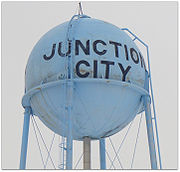
Junction City, Wisconsin
Encyclopedia

Portage County, Wisconsin
Portage County is a county in the U.S. state of Wisconsin. As of 2000, the population was 67,182. Its county seat is Stevens Point. The United States Census Bureau's Stevens Point Micropolitan Statistical Area includes all of Portage County.-Geography:...
, Wisconsin
Wisconsin
Wisconsin is a U.S. state located in the north-central United States and is part of the Midwest. It is bordered by Minnesota to the west, Iowa to the southwest, Illinois to the south, Lake Michigan to the east, Michigan to the northeast, and Lake Superior to the north. Wisconsin's capital is...
, United States
United States
The United States of America is a federal constitutional republic comprising fifty states and a federal district...
. The population was 440 at the 2000 census.
Geography
Junction City is located at 44°35′29"N 89°45′52"W (44.591291, -89.764435).According to the United States Census Bureau
United States Census Bureau
The United States Census Bureau is the government agency that is responsible for the United States Census. It also gathers other national demographic and economic data...
, the village has a total area of 1.2 square miles (3.1 km²), all of it land.
History
As the name suggests, the village grew up around the meeting point of two important railroad lines; the East-West route of the former Soo Line RailroadSoo Line Railroad
The Soo Line Railroad is the primary United States railroad subsidiary of the Canadian Pacific Railway , controlled through the Soo Line Corporation, and one of seven U.S. Class I railroads. Although it is named for the Minneapolis, St. Paul and Sault Ste...
from Stevens Point to Marshfield, and the North-South route of the former Milwaukee Road from Wisconsin Rapids to Wausau. Both rail lines are now part of Canadian National Railway
Canadian National Railway
The Canadian National Railway Company is a Canadian Class I railway headquartered in Montreal, Quebec. CN's slogan is "North America's Railroad"....
.
Demographics
As of the censusCensus
A census is the procedure of systematically acquiring and recording information about the members of a given population. It is a regularly occurring and official count of a particular population. The term is used mostly in connection with national population and housing censuses; other common...
of 2000, there were 440 people, 169 households, and 106 families residing in the village. The population density
Population density
Population density is a measurement of population per unit area or unit volume. It is frequently applied to living organisms, and particularly to humans...
was 370.4 people per square mile (142.8/km²). There were 193 housing units at an average density of 162.5 per square mile (62.6/km²). The racial makeup of the village was 96.82% White, 1.59% Asian, 0.45% from other races
Race (United States Census)
Race and ethnicity in the United States Census, as defined by the Federal Office of Management and Budget and the United States Census Bureau, are self-identification data items in which residents choose the race or races with which they most closely identify, and indicate whether or not they are...
, and 1.14% from two or more races. Hispanic or Latino of any race were 4.32% of the population.
There were 169 households out of which 33.7% had children under the age of 18 living with them, 45.6% were married couples
Marriage
Marriage is a social union or legal contract between people that creates kinship. It is an institution in which interpersonal relationships, usually intimate and sexual, are acknowledged in a variety of ways, depending on the culture or subculture in which it is found...
living together, 13.0% had a female householder with no husband present, and 36.7% were non-families. 31.4% of all households were made up of individuals and 15.4% had someone living alone who was 65 years of age or older. The average household size was 2.60 and the average family size was 3.24.
In the village the population was spread out with 31.8% under the age of 18, 7.7% from 18 to 24, 31.4% from 25 to 44, 16.4% from 45 to 64, and 12.7% who were 65 years of age or older. The median age was 33 years. For every 100 females there were 95.6 males. For every 100 females age 18 and over, there were 88.7 males.
The median income for a household in the village was $33,750, and the median income for a family was $42,031. Males had a median income of $31,375 versus $22,727 for females. The per capita income
Per capita income
Per capita income or income per person is a measure of mean income within an economic aggregate, such as a country or city. It is calculated by taking a measure of all sources of income in the aggregate and dividing it by the total population...
for the village was $17,648. About 13.9% of families and 15.8% of the population were below the poverty line, including 25.2% of those under age 18 and 12.8% of those age 65 or over.

